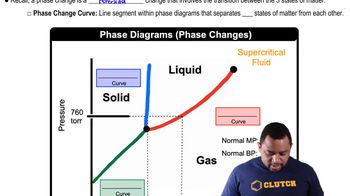Indicate whether each statement is true or false. (a) A reaction that is spontaneous in one direction will be nonspontaneous in the reverse direction under the same reaction conditions. (b) All spontaneous processes are fast. (c) Most spontaneous processes are reversible. (d) An isothermal process is one in which the system loses no heat. (e) The maximum amount of work can be accomplished by an irreversible process rather than a reversible one.
Ch.19 - Chemical Thermodynamics
Chapter 19, Problem 15b
Consider the vaporization of liquid water to steam at a pressure of 1 atm. (b) In what temperature range is it a spontaneous process?

Verified Solution
Video duration:
1mWas this helpful?
Key Concepts
Here are the essential concepts you must grasp in order to answer the question correctly.
Vaporization
Vaporization is the process by which a liquid turns into a gas. For water, this occurs when molecules gain enough energy to overcome intermolecular forces. At 1 atm pressure, water vaporizes at 100°C, but the spontaneity of this process depends on temperature and the Gibbs free energy change.
Recommended video:
Guided course

Raoult's Law and Vapor Pressure
Gibbs Free Energy
Gibbs free energy (G) is a thermodynamic potential that helps predict the spontaneity of a process at constant temperature and pressure. A process is spontaneous when the change in Gibbs free energy (ΔG) is negative. For vaporization, ΔG can be influenced by temperature, pressure, and the enthalpy and entropy changes associated with the phase transition.
Recommended video:
Guided course

Gibbs Free Energy of Reactions
Phase Equilibrium
Phase equilibrium occurs when the rates of vaporization and condensation are equal, resulting in a stable state. At 1 atm, water and steam coexist at 100°C. Above this temperature, vaporization becomes spontaneous as the system favors the gaseous phase, while below it, condensation is favored, indicating the importance of temperature in determining the spontaneity of vaporization.
Recommended video:
Guided course

Phase Changes in Diagrams
Related Practice
Textbook Question
931
views
Textbook Question
(d) Does the amount of work that a system can do on its surroundings depend on the path of the process?
617
views
Textbook Question
Consider the vaporization of liquid water to steam at a pressure of 1 atm. (a) Is this process endothermic or exothermic?
654
views
Textbook Question
Consider the vaporization of liquid water to steam at a pressure of 1 atm. (c) In what temperature range is it a nonspontaneous process?
360
views
Textbook Question
Consider the vaporization of liquid water to steam at a pressure of 1 atm. (d) At what temperature are the two phases in equilibrium?
789
views
Textbook Question
The normal freezing point of n-octane (C8H18) is -57 °C. (b) In what temperature range is the freezing of n-octane a spontaneous process?
747
views
